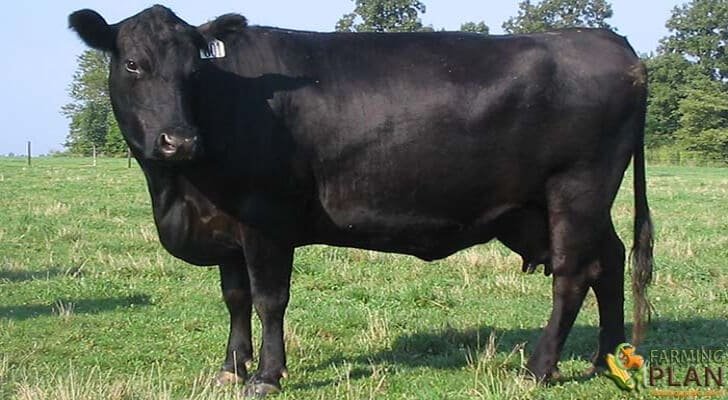Angus cattle are a breed of British origin, coming from the northwest of Scotland. It is possible to characterize by its black coat and mucosa, although the red variety is also very widespread today. It is a breed without horns, it gives excellent breeding mothers, steers of easy fattening to grass, and with this one obtains a product of quality and the tenderness.
Aberdeen Angus cattle are a Scottish breed of small beef cattle. They derive from cattle native to the counties of Angus and Aberdeenshire in north-eastern Scotland. Angus cows are naturally polled and solid black or red, with the udders being white. This article will explore some facts about Angus Cattle that you might not know!

Characteristics of Angus Cattle
The color of the coat is uniform black, the hair is short or of medium length, silky and medium thickness. The skin also has black pigmentation. The Angus cattle, despite its purity, also produce red-coated animals that are already differentiated as a genetic group. In all their characters, both physical and functional, red animals are as good as blacks.
The head is of length between short and medium, wide in the front and wide in the nose and never presents horns. The body is long with a straight and wide back, a great body and thoracic depth and with the ventral line parallel to the dorsal one. The sternum is prominent, the loin broad and the hindquarters long, broad and muscular. You May Also Like To Read Highland Cattle.
The legs are short and have thin bones. The Aberdeen Angus are smaller animals than the Hereford and the Shorthorns and their body is more cylindrical. Modern lines of Angus cattle show higher elevation allowing them to move easily in the prairies. The weight of calves at birth is low, but their rapid growth allows them to overcome this slight disadvantage soon.
The weight range of males at birth is 28 to 34 kg and that of females from 26 to 29 kg. The average live weight of mature bulls is 800 to 950 kg, while cows weigh 500 to 550 kg. Angus is a resistant, docile and a good animal for grazing. Young bulls can reach up to 500 kg. Heifers first stop at 2 or 2.5 years and are usually long-lived.
Where Angus abounds, breeders have been targeting meat for the best butcher trade, and this breed produces high-quality beef with a high percentage of carcass weight.
Food
It’s best to use it in intensive grazing and fattening in the corral. Due to the excellence of their meat, the efficiency of feed conversion to living weight and carcass weight. The fact that black color and absence of horns are dominant can be determined that the Angus has been won the reputation of the first order for cross purposes. It confers features so distinctive to its progeny that it can be used to produce meat animals with dairy breeds that are necessary for substitutions in the cow.
Usage
Angus cattle’s usefulness is for the production of meat. The meat is thin, thick and very tasty, a special steak. The meat extraction yield of young bulls is in the 60-62% range. The cows produce enough milk to give a good initial impulse to the development of the calves and as long as the level of nutrition is kept on a plane.
Young animals can soon develop into bones at a young age or continue their development into mature meat animals. Muscles have a good standardization and the losses by cooking the meat are minimal. The fat layer is thinner than in other breeds and is better distributed in muscle tissue. You May Also Like To Read Jersey cow.
Climate Adaptation
The Angus breed can be adapt better in temperate or cold climates and under grazing systems, in extreme climates with a predominance of a warm climate and in semi-intensive systems.
Special Feature
Angus cattle It is the ideal breed for areas of mount or saw, where the cows in calving can be observed twice a day since it has the peculiarity of fearing fewer problems at birth. It originated in Scotland (Great Britain). Black or red brick whole. They are meek and genetically acorns. Small size. Good maternal instinct and good milk producer.
High-quality meat (it can consider that it is the breed with better marbling in the muscle). This breed is resistant to disease and has moderate demands on feeding and accommodation conditions. The most prominent feature of these breeds is their good reproductive capacity and excellent maternal characteristics.
Heifers are productive at the age of 13 to 15 months, and the breeding procedure is simple. The weight of the newborn calves is 25-30 kg. The cow produces enough milk and takes care of its young. The average weight of the calves after a period of 205 days can reach 300 kg. The maternal race is ideal for cross-combinations.
Conclusion
The Aberdeen Angus is a Scottish breed of small beef cattle that derives from the counties of Aberdeenshire and Angus in north-eastern Scotland. It’s naturally polled, solid black or red, but can have white udders. This guide should help you learn more about this heritage breed! If you want to know how to tell if your cow is an Angus, see our blog post on “How To Tell If Your Cow Is An Anguss” for details. We hope this has been helpful! Good luck with raising these cows!
As A References: Wikipedia


